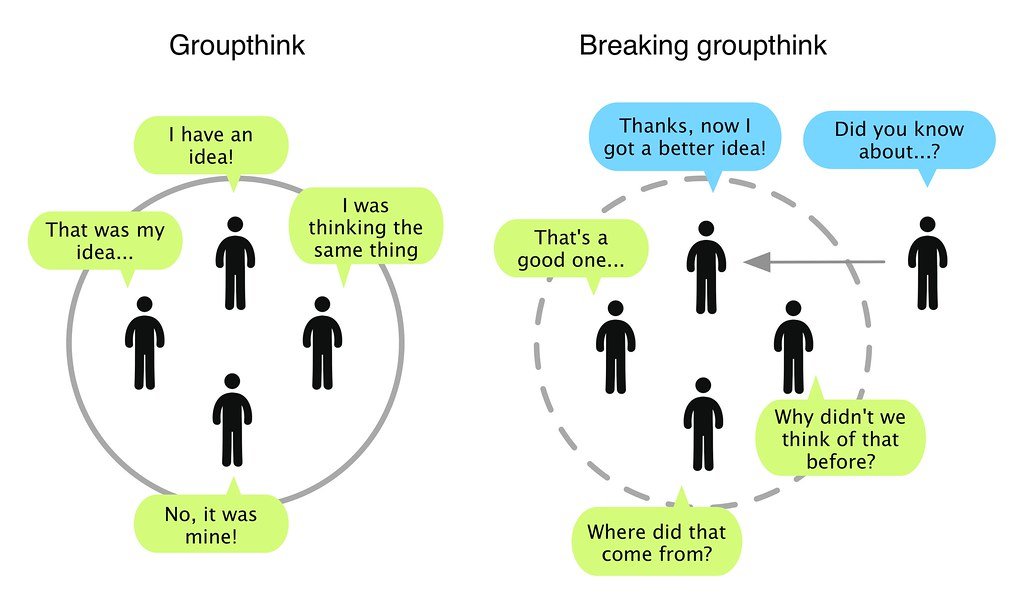
Click below to listen to this article:
Groupthink
Groupthink is a term coined by social psychologist Irving L. Janis in 1972 to describe a psychological phenomenon that occurs within a group of people in which the desire for harmony or conformity in the group results in an irrational or dysfunctional decision-making outcome. In this article, we will discover the history and theoretical basis to groupthink and how it can be avoided.
What is groupthink?
According to Janis, groupthink is characterized by a number of symptoms, such as illusions of unanimity, unquestioned beliefs, rationalizing, stereotyping, self-censorship, illusions of invulnerability, direct pressure to conform, and the presence of “mindguards” who shield the group from problematic information.
These symptoms prevent the group from critically evaluating their beliefs and actions, and lead them to ignore possible moral problems, overlook alternative solutions, underestimate the risks, and demonize the opponents.
The theoretical basis of groupthink is rooted in several psychological processes, such as conformity, social influence, obedience, social identity, and deindividuation. These processes affect how individuals perceive themselves and others in a group context, and how they adjust their behaviour and opinions to fit the group norms and expectations.
Groupthink can have negative consequences for both the group and the society at large, as it can result in poor decisions that negatively impact individuals, organizations, or nations.
Real-life examples of groupthink
Some examples of historical events that have been attributed to groupthink are the Bay of Pigs invasion, the Pearl Harbor attack, the Vietnam War, the Watergate scandal, the Challenger disaster, and the Iraq War.
Some examples of groupthink in history and pop culture are:
The Bay of Pigs Invasion: In 1961, the US government planned to overthrow Fidel Castro’s regime in Cuba by supporting a group of Cuban exiles. However, the plan was poorly executed and failed miserably, resulting in many casualties and political embarrassment. The decision-makers did not question the assumptions or risks of the plan, and ignored the warnings of experts and intelligence reports. They also pressured those who expressed doubts or concerns to conform to the group’s consensus.
The Challenger Space Shuttle Disaster: In 1986, NASA launched the space shuttle Challenger despite knowing that there were problems with the O-rings that sealed the rocket boosters. The engineers who raised the issue were overruled by the managers, who wanted to meet the launch schedule and avoid further delays. The shuttle exploded shortly after lift-off, killing all seven crew members on board. The investigation revealed that NASA had a culture of groupthink that prevented effective communication and risk assessment.
Watergate: In 1972, President Richard Nixon and his aides orchestrated a break-in at the Democratic National Committee headquarters at the Watergate complex in Washington, D.C. They also tried to cover up their involvement by lying, destroying evidence, and obstructing justice. The scandal eventually led to Nixon’s resignation in 1974. The Watergate conspirators exhibited many symptoms of groupthink, such as rationalizing their illegal actions, stereotyping their opponents, censoring dissenting views, and isolating themselves from outside sources of information.
Kony 2012: In 2012, a viral video campaign called Kony 2012 was launched by a non-profit organization called Invisible Children. The video aimed to raise awareness and support for the capture of Joseph Kony, a notorious warlord in Uganda who was accused of abducting and exploiting children as soldiers and sex slaves. The video received millions of views and donations, but also faced criticism for oversimplifying the situation, misrepresenting the facts, and exploiting emotions. Many people who shared or supported the video did not question its accuracy or motives, and were influenced by the social pressure and popularity of the campaign.
How to avoid groupthink
To avoid or reduce groupthink, some strategies that have been suggested are encouraging dissent and diversity of opinions, seeking external feedback and information, appointing a devil’s advocate or a critical evaluator, breaking the group into subgroups or individuals, setting clear decision-making criteria and procedures, and fostering a culture of openness and trust.
To avoid groupthink, here are some examples of what you can do:
- Encourage critical thinking and constructive feedback among group members. Don’t be afraid to challenge assumptions, ask questions, or point out potential problems.
- Seek out diverse perspectives and opinions from outside sources. Invite experts, stakeholders, or outsiders to review your group’s work and provide feedback.
- Assign a devil’s advocate role to someone in the group who can play the opposite side of the argument and raise objections or alternatives. This can help stimulate debate and prevent premature consensus.
- Establish clear criteria and methods for evaluating decisions and solutions. Use evidence, data, and logic to support your arguments and test your assumptions.
- Avoid excessive pressure or influence from leaders or authority figures. Leaders should encourage open communication and participation, rather than impose their views or preferences on the group.
Further reading
If you would like to learn more about groupthink, its causes, effects, examples, and how to avoid it, you can check out the following weblinks:
Groupthink | Wikipedia:
Groupthink: Definition, Signs, Examples, and How to Avoid It | Verywell Mind:
Groupthink | Psychology Today:


0 Comments